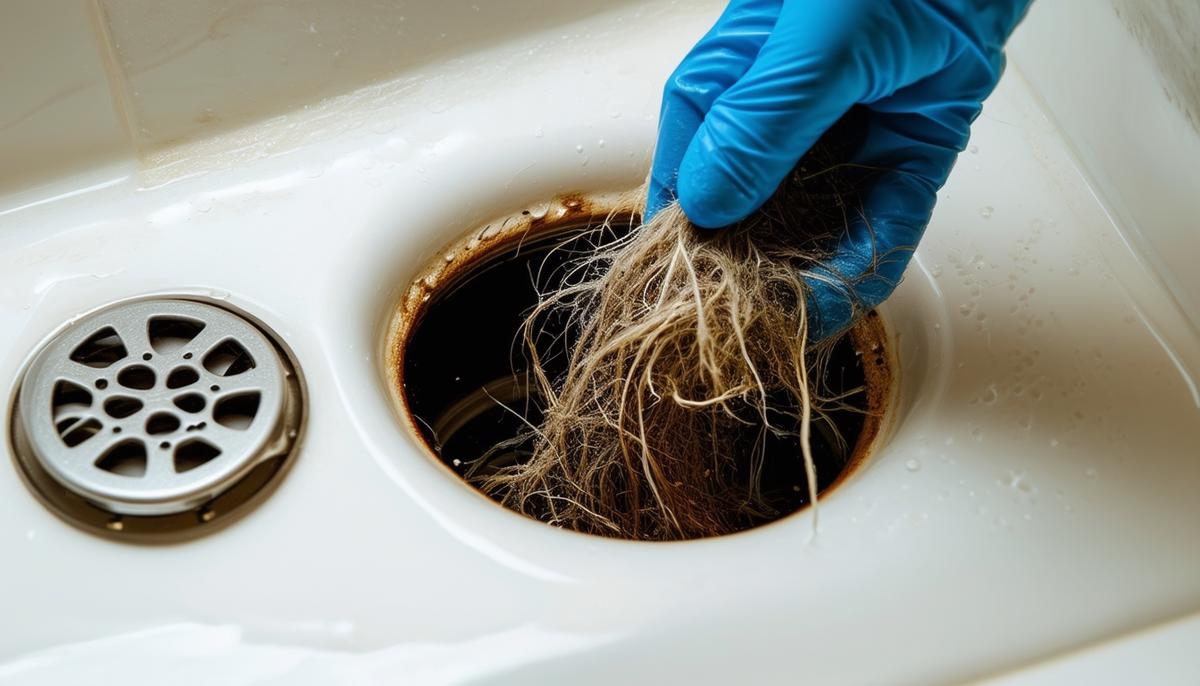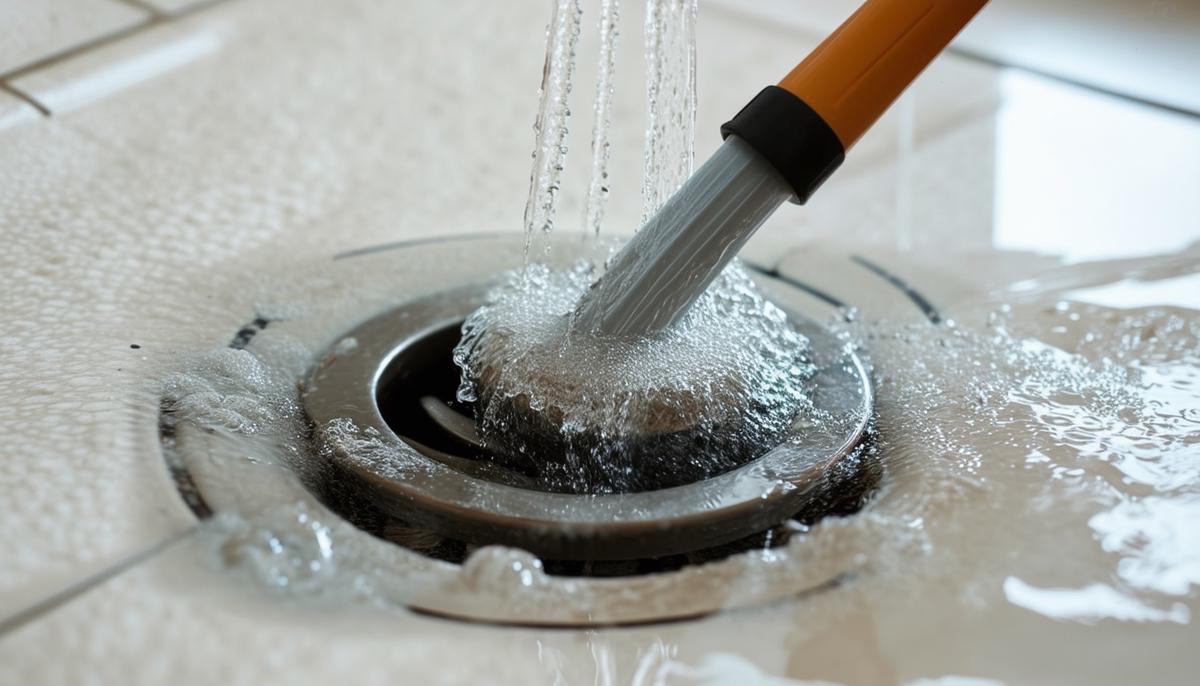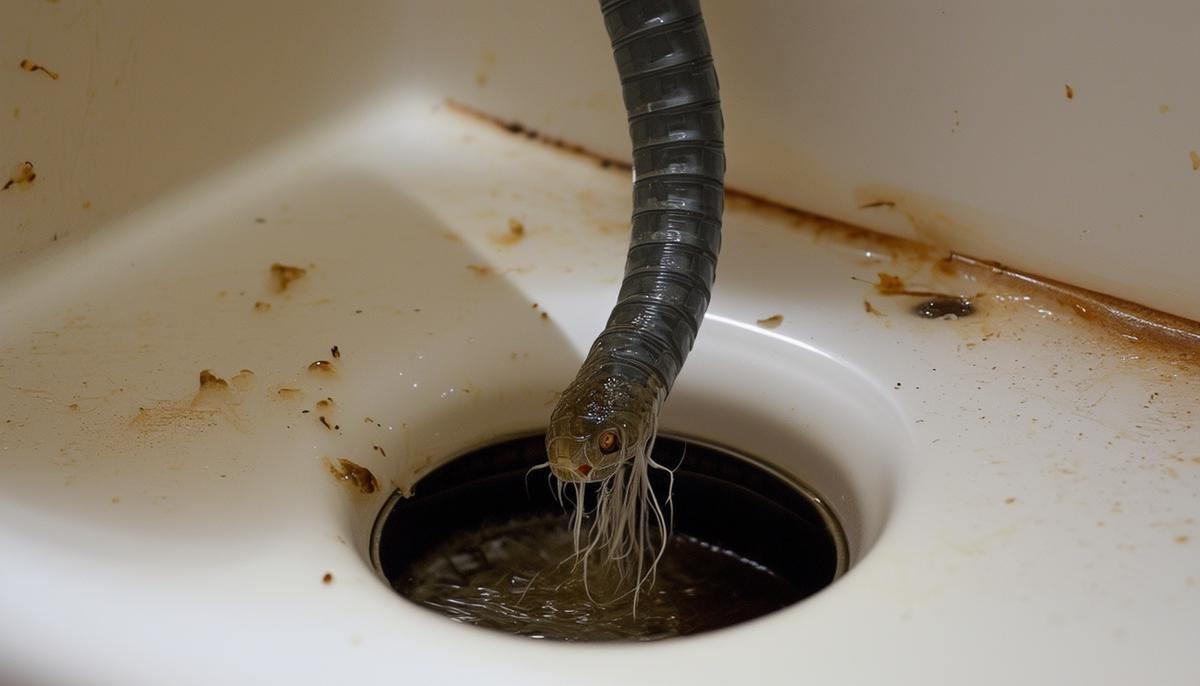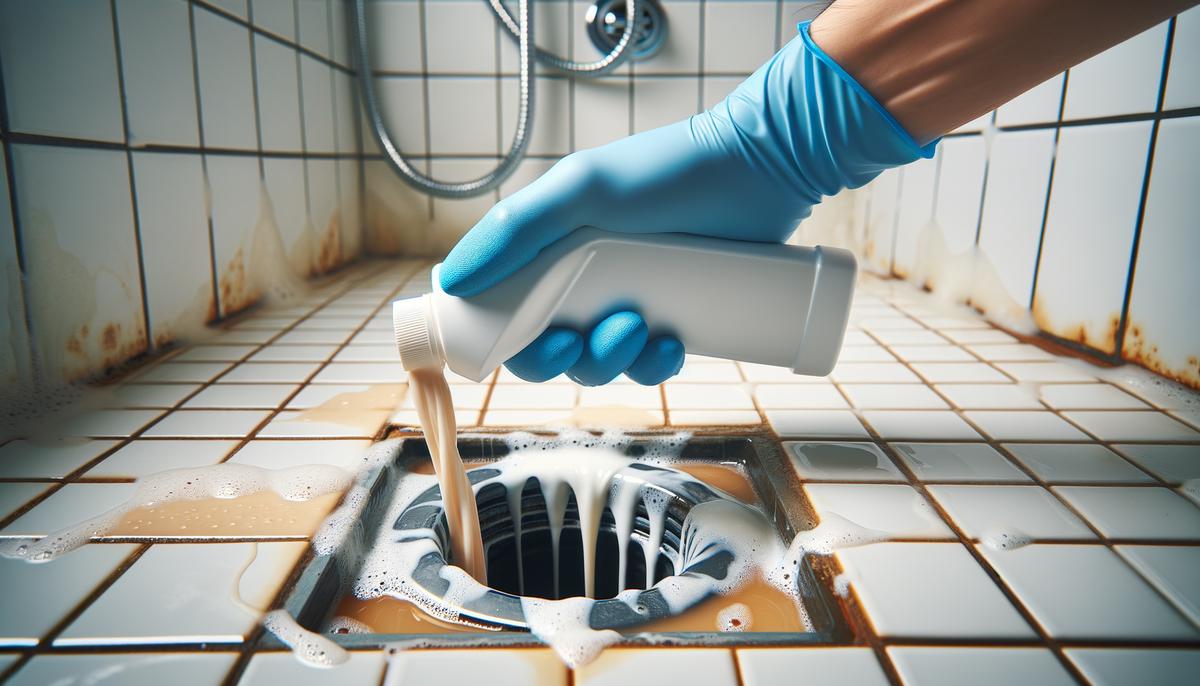Removing Visible Debris and Hair
Let any standing water drain as much as possible. Remove any stoppers and the drain cover. It may be screwed in, so you'll need a screwdriver – or if you're anything like me, a butter knife might do the trick! Just twist or pry it off gently. You might want to cover your eyes or hold your breath —what you'll find there might make your stomach turn.
Now, with rubber gloves on (optional but highly recommended), it's time to clean up the hair and product buildup on the surrounding surface. Get a garbage bag handy because you'll be pulling out a lot of gunk. Scissors or tweezers can come in handy for those stubborn hair clumps tangled like a sibling's neglected doll collection. Yank out as much as you can, and don't be shy – the more you pull out, the better.
Look down the drain. If you spot any more loose hairs or debris, a wire hanger can be your best friend. Straighten it out, create a small hook at the end, and go fishing. Be gentle but persistent. This isn't exactly a day at the lake, but it needs the same steady hand.
Once you've cleared as much as you can see and reach, run the water to see if it's still clogged. If the water flows freely, give yourself a pat on the back; you've just saved yourself a plumber's bill! If not, well, at least you've laid the groundwork. Time to bring in the big guns, like a plunger or a vinegar and baking soda mix.

Using Vinegar and Baking Soda Mixture
Once the visible debris and hair are removed, it's time to tackle the gunk that's lurking deeper in the pipes. One of the most effective—and budget-friendly—methods is using a vinegar and baking soda mixture. This DIY cleaner works wonders on clogs and leaves your drain smelling fresh.
Start by mixing ½ cup of baking soda with ¼ cup of table salt. This combination seems simple, but it packs a punch against all that stubborn grime. Carefully pour this mixture down the drain. Now, heat up 1 cup of vinegar—you don't need it to be boiling, just hot enough to be effective. Pour the heated vinegar down the drain right after the baking soda and salt mix.
Prepare yourself for a bit of a science experiment because the mixture will start to foam and bubble, almost like you're performing a magic trick. Let this fizzy combo sit in your drain for about 15 minutes. During this time, the chemical reaction will work its way through the gunk and grease built up inside your pipes, breaking down all those nasty blockages.
After the foaming has settled and the 15 minutes are up, run hot tap water down the drain for at least 15 to 30 seconds to wash away any remaining debris. This final step is crucial because the hot water helps to flush all the dissolved gunk right out of your plumbing system, leaving your shower drain clear and functioning smoothly.
Consider doing this every month or so as part of your regular cleaning routine. This easy mixture not only unclogs your drain but also helps prevent those annoying blockages from forming in the first place. Regular maintenance goes a long way in keeping your drains—and your showers—running smoothly.

Unclogging a Shower Drain with a Plunger
If the vinegar and baking soda mixture doesn't fully clear the clog, it's time to bring out the plunger. After removing the drain cover, run some water to cover the bottom of the plunger cup. Not too much—you just need enough to create good suction. Press the plunger firmly over the drain to form a tight seal.
Now, move the plunger up and down with brisk motions. The goal is to create enough suction and pressure to dislodge whatever is still lingering down there. You might need to plunge vigorously for about a minute or two. Keep an eye on the movement of water; if you notice it starting to flow down more freely, that's a great sign.
If the water begins to drain smoothly while you're plunging, let out a cheer! This means you've successfully loosened the blockage. If the water seems stubborn, you may need to reset and plunge a few more times.
Once the water starts draining properly, give the area a good rinse with hot water to flush away any residual debris. Regular maintenance with plunging, combined with the vinegar and baking soda routine, can keep these nasty blockages at bay.

Using a Plumber's Snake
For those times when plunging doesn't quite cut it, it's time to call in the plumber's snake. This trusty tool is designed to wriggle its way through your pipes. A plastic drain snake like the Vastar Drain Snake can work wonders in getting rid of those stubborn clogs.
First, insert the snake into the drain. You'll want to gently guide it down until you feel some resistance. That resistance is the culprit—hair, soap scum, and other debris that's decided to set up camp in your drain. Twist the snake around, aiming to snag all the gunk clinging to your pipe walls.
As you twist, you'll feel the snake either snag on something or start to push through. Both reactions are good signs. If it's snagged, you've caught some hair or debris. Pull it up slowly to bring the blockage to the surface. If it's pushing through, you're breaking up the clog and sending it on its way down the drain.
Once you've dislodged the blockage, remove the snake and dispose of the debris properly. After using the snake, run hot water down the drain to thoroughly flush out any remaining particles. This helps to ensure that any bits and pieces that the snake pushed loose are fully cleared away. If your drain still seems a bit sluggish, a follow-up round with the vinegar and baking soda mixture can help finish the job and leave your pipes sparkling.
Using a plumber's snake might seem a bit intimidating at first, but once you get the hang of it, it's an invaluable tool in your drain-clearing arsenal. Regular maintenance and an occasional snaking can keep your drains clear and save you from the hassle—and expense—of calling in a professional plumber for minor clogs.

Utilizing Chemical Drain Cleaners
If home remedies have left you high and dry, it might be time to turn to chemical drain cleaners. These powerful concoctions can be just the thing you need to blast through stubborn clogs and get your drain flowing freely again. However, they pack a punch, so it's crucial to handle them with care and respect.
First off, make sure you're picking a cleaner suitable for the job. There are various types available—some that focus on hair clogs, others on grease. Products like Drano Max Gel Drain Clog Remover and Liquid-Plumr Hair Clog Eliminator have proven effective, but it's important to choose one that's specifically formulated for your type of clog.
Before you get started, safety is paramount. Wear rubber gloves and eye protection to shield yourself from any potential splashes. Chemical drain cleaners can be quite harsh, so you don't want any of it coming into contact with your skin or eyes. Also, work in a well-ventilated area. Open a window or turn on a fan to ensure you're not inhaling any fumes. Ventilation is crucial—it not only protects you but also helps dissipate any unpleasant odors.
Now, read the instructions on your chosen product carefully. Each brand will have its own set of directions, and following them to the letter ensures the cleaner works effectively and safely. Typically, you'll need to pour a specified amount of the cleaner directly into the drain. Avoid splashing as you pour and, if possible, pour it slowly to minimize the risk of backflow.
After pouring the chemical cleaner, patience is key. Most products require you to let the cleaner sit for a notable amount of time—anywhere from 15 minutes to overnight—depending on the severity of the clog. This waiting period allows the chemicals to break down the gunk obstructing your pipes.
Once the waiting period is up, flush the drain with plenty of hot water. This final rinse is crucial because it helps to carry away not only the remnants of the clog but also any lingering chemical residue. Ensure the water is running freely before you consider the job done. If the first application doesn't completely clear the blockage, you may need to repeat the process. Just make sure to give your pipes some time to rest in between treatments, and check for any advisories on the product label regarding multiple applications.
While chemical drain cleaners can be incredibly effective, they should be used sparingly. Over-reliance on these harsh chemicals can potentially damage your pipes, especially if you have an older plumbing system. They're great for occasional heavy-duty cleanings, but for regular maintenance, stick to less abrasive methods like the trusty vinegar and baking soda combo.

Preventing Future Clogs
To keep your shower drain clog-free, consider installing a drain strainer. This simple yet effective device can be a game-changer in your drain maintenance routine. Drain strainers, or covers, are designed to catch hair, soap particles, and other debris before they get a chance to make a home in your pipes. They are easy to install and require minimal effort to maintain—just pop one into your drain, and you're good to go.
You'll find plenty of drain strainers on the market, and they come in various shapes and materials. Opt for one that fits snugly into your drain to ensure it catches everything without interrupting the flow of water. Stainless steel options are durable and easy to clean, while silicon strainers offer flexibility and can fit into slightly irregularly shaped drains.
To keep your strainer doing its job effectively, make it a habit to clean it out after each shower. This might sound like a chore, but it only takes a minute and prevents larger problems down the line. Simply lift the strainer out, remove the trapped hair and debris, and rinse it off before putting it back in place. Keeping on top of this small task can make a big difference in the long run.
Aside from using a drain strainer, incorporating a monthly cleaning routine with drain cleaners can keep buildup at bay. You can choose between commercial drain cleaners, which are formulated to tackle various types of clogs, or a homemade mixture of vinegar and baking soda, which is gentler on your plumbing.
Regular maintenance is the key to keeping your drains in good working order. Make these practices part of your household routine:
- Weekly: Flush your drains with hot water to help dissolve soap scum and grease.
- Monthly: Use a commercial drain cleaner or the vinegar and baking soda mixture as described above.
- Daily: Clean the drain strainer after every use.
By being proactive and incorporating these simple steps into your cleaning routine, you can easily prevent the annoyance of a clogged shower drain. This not only ensures a pleasant shower experience but also keeps your plumbing system healthy and free from potential damage.

Revolutionize your content with Writio, an AI content writer that elevates your website with quality writing. This article was crafted by Writio.
- Aranda A, Goehring L. The physics of clogged drains: dynamics of hair entanglements and clogs in pipes. Phys Rev Fluids. 2020;5(3):034302.
- Verma P, Sahu PK, Srivastava RK. A review on drain cleaning methods and tools. Int J Adv Res Sci Eng. 2019;8(4):1182-1188.
- Gholami M, Nasseri S, Feng CY, Thompson M. Evaluation of a new ultra-safe alkaline chemistry for cleaning and disinfection of drains and surfaces. Am J Infect Control. 2012;40(8):e195-e199.
Leave a Reply